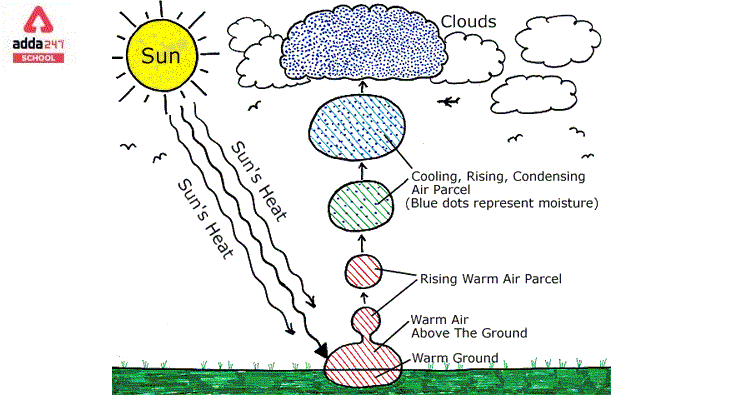How are Clouds formed?- We do wonder a lot about nature and its mysteries. How things work in our nature is actually phenomenal. Here, we will get to know about how clouds are actually formed.
How are Clouds Formed Class 3 and 6
Clouds are formed naturally when air can no longer carry any more water vapour. This is known as the saturation point, and there are two ways to attain it. First, moisture builds up until the volume of air can no longer hold any more. The other way lowers the temperature of the moist air, so reducing the quantity of moisture it can hold. Evaporation and condensation, respectively, are used to obtain saturation. Moisture creates visible water droplets in the form of fog and clouds when it reaches saturation.
The horizontal movement of air, that is wind, moves energy as sensible and latent heat from the earth’s surface. Conduction and convection transport sensible heat. Convection transfers energy through the vertical movement of a heated substance, while conduction transfers energy within a substance. The transfer of energy via altering the substance itself is referred to as latent heat. Evaporation is the process of turning a liquid into a gas; condensation is the process of turning a gas into a liquid; solidification (freezing) is the process of turning a liquid into a solid, and fusion is the process of turning a solid into a liquid (melting); Water can also be converted directly from a solid to a gas (sublimation) or the other way around (deposition). These processes can be seen in the production of clouds.
Read About: Why the Sun is called a Star?
What are Clouds Made of
What are Clouds made of, the Answer of this Question is Clouds are created when water vapor, an invisible gas, turns into liquid water droplets. These water droplets form on tiny particles, like dust, that are floating in the air.
बादल कैसे बनते हैं Class 1, 3 in Hindi
बादल प्राकृतिक रूप से तब बनते हैं जब हवा अब और जलवाष्प नहीं ले जा सकती। इसे संतृप्ति बिंदु के रूप में जाना जाता है, और इसे प्राप्त करने के दो तरीके हैं। सबसे पहले, नमी तब तक बनती है जब तक हवा की मात्रा अब और नहीं रह सकती। दूसरा तरीका नम हवा के तापमान को कम करता है, जिससे नमी की मात्रा कम हो सकती है। संतृप्ति प्राप्त करने के लिए क्रमशः वाष्पीकरण और संघनन का उपयोग किया जाता है। नमी संतृप्ति तक पहुंचने पर कोहरे और बादलों के रूप में पानी की बूंदें दिखाई देती हैं।
हवा की क्षैतिज गति, यानी हवा, पृथ्वी की सतह से ऊर्जा को समझदार और गुप्त गर्मी के रूप में ले जाती है। चालन और संवहन परिवहन समझदार गर्मी। संवहन एक गर्म पदार्थ के ऊर्ध्वाधर आंदोलन के माध्यम से ऊर्जा स्थानांतरित करता है, जबकि चालन किसी पदार्थ के भीतर ऊर्जा स्थानांतरित करता है। पदार्थ में परिवर्तन करके ऊर्जा के हस्तांतरण को गुप्त ऊष्मा कहा जाता है। वाष्पीकरण एक तरल को गैस में बदलने की प्रक्रिया है; संघनन एक गैस को तरल में बदलने की प्रक्रिया है; जमना (ठंड) एक तरल को ठोस में बदलने की प्रक्रिया है, और संलयन एक ठोस को तरल (पिघलने) में बदलने की प्रक्रिया है; पानी को ठोस से सीधे गैस (उच्च बनाने की क्रिया) या दूसरी तरफ (निक्षेपण) में भी परिवर्तित किया जा सकता है। इन प्रक्रियाओं को बादलों के उत्पादन में देखा जा सकता है।
Read About: Does Moon has its own light?









 HPBOSE Compartment Date Sheet 2025 Out, ...
HPBOSE Compartment Date Sheet 2025 Out, ...
 RUHS Counselling 2025 Round 1 Seat Allot...
RUHS Counselling 2025 Round 1 Seat Allot...
 Bihar Board Dummy Registration Card 2026...
Bihar Board Dummy Registration Card 2026...










